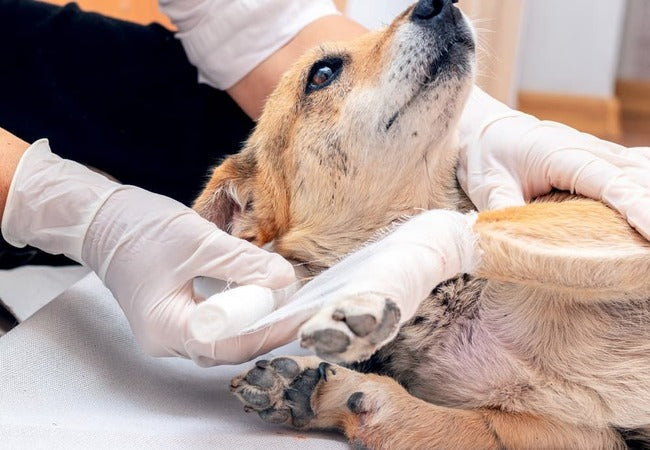Veterinary Guide to Canine Tetanus 2025: Symptoms, Treatment & Recovery 🐾🩺

In this article
Veterinary Guide to Canine Tetanus 2025: Symptoms, Treatment & Recovery 🐾🩺
By Dr. Duncan Houston BVSc
Overview
Tetanus in dogs, though rare, is a serious neurological condition caused by the Clostridium tetani toxin. The disease usually enters through a deep or contaminated wound and can cause stiffening of muscles, spasms, and severe systemic illness. Early detection and aggressive treatment can be lifesaving.
🧬 How Dogs Get Tetanus
- C. tetani spores in soil, dust, or feces enter wounds—particularly deep, anaerobic puncture wounds.
- Toxin (tetanospasmin) travels through nerves to the spinal cord and brain, blocking inhibitory neurotransmitters and causing uncontrolled muscle contractions.
- Incubation period ranges from 3 to 21 days, typically 5–10 days.
Localized vs Generalized Tetanus 🧩
- Localized tetanus: Stiffness near the wound site, often limbs or jaw; may resolve with targeted treatment.
- Generalized tetanus: Progression to stiff jaw (lockjaw), neck rigidity, sawhorse stance, back arching, tail extension, facial spasms (risus sardonicus), and life-threatening breathing issues.
✅ Clinical Signs to Watch For
- Stiffness or rigidity of jaw, neck, back, or limbs
- Sawhorse posture—hind legs stiff and extended
- Facial spasms, drooling, difficulty swallowing
- Muscle tremors triggered by noise or touch
- Fever due to muscle activity, difficulty breathing, recumbency
🔍 Diagnosing Tetanus
- Clinical diagnosis based on wound history and characteristic signs.
- Optional bloodwork reveals elevated white cells, chemical changes.
- Rule out similar conditions (e.g., poisoning, meningitis).
🫀 Step-by-Step Treatment
1. Wound Care & Debridement
Thoroughly clean wounds under sedation if required, removing necrotic tissue and flushing with antiseptics like hydrogen peroxide.
2. Antitoxin Administration
- Equine tetanus antitoxin neutralizes unbound toxin; must be given early.
- Dosage: 100–1,000 IU/kg IV after test dose; risk of allergic reaction—monitor closely.
3. Antibiotic Therapy
Metronidazole (10–15 mg/kg IV q8h) is preferred due to tissue penetration and lower side effects than penicillin. Alternatives include erythromycin, tetracyclines, clindamycin for ≥10 days.
4. Control of Spasms & Muscle Rigidity
- Benzodiazepines (e.g., diazepam) or muscle relaxants reduce spasms.
- Acepromazine or methocarbamol may be used cautiously —but atropine, acepromazine linked to poorer outcomes.
5. Intensive Supportive Care
- IV fluids to maintain hydration and support kidneys.
- Keep the dog in a quiet, dim, low-stimulation environment to decrease triggers.
- Regular repositioning to prevent sores on recumbent dogs.
- Feeding tube or assisted feeding if jaw is immobile; airway management if needed.
- Supplemental oxygen and monitor for aspiration pneumonia.
📊 Prognosis & Survival
Survival rates vary with severity—from 50–90%. Localized tetanus often has full recovery, while generalized tetanus has a guarded prognosis without aggressive care.
A retrospective study showed 32 of 42 dogs survived with proper treatment. Worse outcomes were linked to young dogs, rapid disease onset, lack of early antibiotics, use of acepromazine/atropine, hyperthermia, and respiratory issues.
Recovery is prolonged—often weeks to months—with muscle stiffness resolving last.
🏠 Home Care & Rehabilitation
- Quiet area with soft bedding and minimal stimulation.
- Assist with feeding, hydration, bathroom breaks.
- Perform gentle physical therapy to avoid stiffness.
- Prevent wounds and monitor any new injuries.
- Regular vet checkups to adjust medication and monitor recovery.
🛡️ Prevention in 2025
- Prompt attention to wounds: clean, flush, debride, antibiotics.
- Dogs aren’t routinely vaccinated, but human toxoid may be used off-label after major wounds.
- Use protective gear outdoors to avoid deep puncture wounds.
- Maintain regular veterinary checkups and wound inspections.
🧭 Why 2025 Is Different
- Updated antibiotic protocols favor metronidazole over penicillin.
- Advanced sedation and nurturing care reduce spasm triggers.
- Enhanced nutritional and airway support tools in practice.
- Telehealth through Ask A Vet enables remote monitoring and early intervention.
🔧 Role of Ask A Vet
- Ask A Vet: 24/7 vet support for wound assessment, early signs triage, medication plans, and step-by-step recovery guidance.
👨⚕️ Final Thoughts from Dr Duncan
Tetanus is treatable—even life-threatening cases—with timely wound care, appropriate medications, and supportive nursing. In 2025, we combine evidence-based medicine with telehealth access and enhanced home care to give affected dogs the best chance of recovery. If your dog has a deep or contaminated wound, or shows stiffness or spasms, seek veterinary care immediately. Early action truly saves lives. 💙
Visit AskAVet.com or download the Ask A Vet app for trusted, round-the-clock veterinary guidance through any neurological or wound-related emergency.






